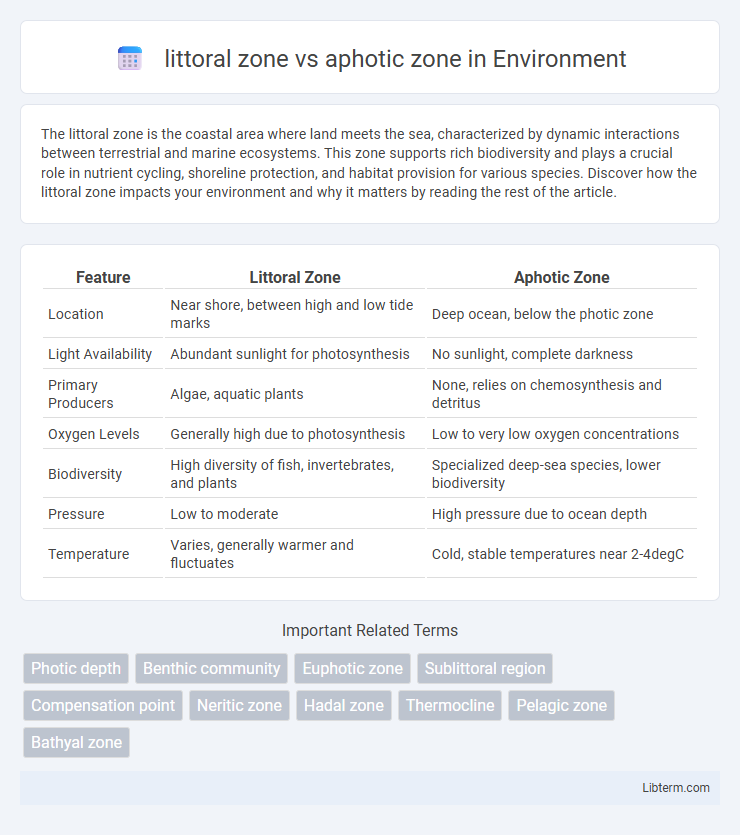The littoral zone is the coastal area where land meets the sea, characterized by dynamic interactions between terrestrial and marine ecosystems. This zone supports rich biodiversity and plays a crucial role in nutrient cycling, shoreline protection, and habitat provision for various species. Discover how the littoral zone impacts your environment and why it matters by reading the rest of the article.
Table of Comparison
| Feature | Littoral Zone | Aphotic Zone |
|---|---|---|
| Location | Near shore, between high and low tide marks | Deep ocean, below the photic zone |
| Light Availability | Abundant sunlight for photosynthesis | No sunlight, complete darkness |
| Primary Producers | Algae, aquatic plants | None, relies on chemosynthesis and detritus |
| Oxygen Levels | Generally high due to photosynthesis | Low to very low oxygen concentrations |
| Biodiversity | High diversity of fish, invertebrates, and plants | Specialized deep-sea species, lower biodiversity |
| Pressure | Low to moderate | High pressure due to ocean depth |
| Temperature | Varies, generally warmer and fluctuates | Cold, stable temperatures near 2-4degC |
Introduction to Aquatic Zones
The littoral zone is the shallow, sunlit area near the shore where aquatic plants thrive and diverse animal life is abundant due to abundant sunlight and nutrient availability. The aphotic zone lies deeper in aquatic environments, characterized by complete darkness where photosynthesis is impossible, supporting organisms adapted to low light and high pressure. Understanding these zones is crucial for studying aquatic ecosystems, biodiversity, and energy flow in freshwater and marine habitats.
Defining the Littoral Zone
The littoral zone is the part of a water body closest to the shore, extending from the high water mark to areas where sunlight reaches the bottom, allowing aquatic plants to thrive. This zone supports a diverse ecosystem due to its abundant sunlight and nutrient availability, contrasting sharply with the aphotic zone where light penetration is minimal or absent. The aphotic zone begins where sunlight can no longer sustain photosynthesis, resulting in limited plant life and a reliance on detritus and chemosynthesis for energy.
Characteristics of the Aphotic Zone
The aphotic zone is a deep ocean layer where sunlight fails to penetrate, resulting in complete darkness and extremely low temperatures. Unlike the illuminated littoral zone, the aphotic zone has high pressure and limited biodiversity, dominated by bioluminescent organisms and scavengers adapted to scarce food sources. This zone plays a crucial role in carbon sequestration and nutrient recycling within marine ecosystems.
Light Availability: Littoral vs Aphotic Zones
The littoral zone, located near the shore of a water body, receives abundant sunlight that penetrates through the shallow waters, enabling photosynthesis and supporting diverse aquatic vegetation. In contrast, the aphotic zone lies deeper in the water column where light is insufficient or completely absent, preventing photosynthesis and limiting life primarily to organisms adapted to darkness. This stark difference in light availability directly influences the biological communities, with the littoral zone hosting photosynthetic plants and the aphotic zone dominated by specially adapted fauna and detritus-based ecosystems.
Biodiversity and Adaptations
The littoral zone, characterized by abundant sunlight and nutrient availability, supports high biodiversity with numerous aquatic plants, fish, and invertebrates exhibiting adaptations like specialized root systems and camouflage for survival. In contrast, the aphotic zone lacks sunlight, resulting in fewer species but unique adaptations such as bioluminescence, slow metabolism, and enhanced sensory organs to navigate and find food. These zones showcase distinct ecological niches where organisms evolve specialized traits to thrive under vastly different environmental conditions.
Primary Productivity Differences
The littoral zone exhibits high primary productivity due to abundant sunlight penetration and nutrient availability, supporting diverse aquatic plants and algae. In contrast, the aphotic zone, characterized by the absence of sunlight, relies on chemosynthesis and detrital matter for energy, resulting in significantly lower primary productivity. These fundamental differences shape ecosystem dynamics and energy flow within aquatic environments.
Ecological Roles in Aquatic Ecosystems
The littoral zone supports high biodiversity by providing critical habitats for aquatic plants, invertebrates, and fish due to ample sunlight penetration and nutrient availability. In contrast, the aphotic zone, located deeper with no sunlight, plays a key role in nutrient recycling and houses specialized organisms adapted to low-light conditions, such as bioluminescent species and detritivores. Together, these zones maintain aquatic ecosystem stability by balancing primary production in the littoral zone with organic matter decomposition in the aphotic zone.
Human Impacts on Littoral and Aphotic Zones
Human activities significantly impact littoral zones through coastal development, pollution, and habitat destruction, leading to reduced biodiversity and disrupted ecosystems. In aphotic zones, deep-sea mining and submarine cable installations disturb fragile benthic habitats, affecting species adapted to low-light environments. Both zones face challenges from climate change, which alters water temperature and chemistry, further threatening marine life and ecosystem resilience.
Conservation Challenges and Strategies
Littoral zones face conservation challenges due to pollution, habitat destruction, and invasive species, requiring strategies such as habitat restoration, pollution control, and protective legislation to preserve biodiversity. Aphotic zones confront difficulties from deep-sea mining, climate change, and limited scientific knowledge, making conservation efforts reliant on establishing marine protected areas and advancing deep-sea research technologies. Both zones demand integrated ecosystem management and international cooperation to address their unique vulnerabilities effectively.
Summary: Key Differences and Importance
The littoral zone, located in shallow coastal waters with abundant sunlight, supports diverse aquatic plant and animal life crucial for ecosystem productivity. In contrast, the aphotic zone exists in deeper waters beyond light penetration, relying on detritus and chemosynthesis for energy, with limited biodiversity adapted to extreme conditions. Understanding these zones highlights their distinct ecological roles, influencing marine biodiversity conservation and resource management strategies.
littoral zone Infographic

 libterm.com
libterm.com